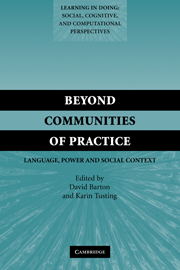Book contents
- Frontmatter
- Contents
- List of Contributors
- Series Foreword
- Introduction
- 1 Literacy, reification and the dynamics of social interaction
- 2 Language and power in communities of practice
- 3 Mediating allegations of racism in a multiethnic London school: what speech communities and communities of practice can tell us about discourse and power
- 4 “I've picked some up from a colleague”: language, sharing and communities of practice in an institutional setting
- 5 The person in the doing: negotiating the experience of self
- 6 Communities of practice and learning communities: do bilingual co-workers learn in community?
- 7 Moving beyond communities of practice in adult basic education
- 8 ‘Communities of practice’ in higher education: useful heuristic or educational model?
- 9 Communities of practice, risk and Sellafield
- 10 Semiotic social spaces and affinity spaces: from The Age of Mythology to today's schools
- Author Index
- Subject Index
- LEARNING IN DOING
- References
10 - Semiotic social spaces and affinity spaces: from The Age of Mythology to today's schools
Published online by Cambridge University Press: 24 November 2009
- Frontmatter
- Contents
- List of Contributors
- Series Foreword
- Introduction
- 1 Literacy, reification and the dynamics of social interaction
- 2 Language and power in communities of practice
- 3 Mediating allegations of racism in a multiethnic London school: what speech communities and communities of practice can tell us about discourse and power
- 4 “I've picked some up from a colleague”: language, sharing and communities of practice in an institutional setting
- 5 The person in the doing: negotiating the experience of self
- 6 Communities of practice and learning communities: do bilingual co-workers learn in community?
- 7 Moving beyond communities of practice in adult basic education
- 8 ‘Communities of practice’ in higher education: useful heuristic or educational model?
- 9 Communities of practice, risk and Sellafield
- 10 Semiotic social spaces and affinity spaces: from The Age of Mythology to today's schools
- Author Index
- Subject Index
- LEARNING IN DOING
- References
Summary
INTRODUCTION: FROM GROUPS TO SPACES
In this paper, I consider an alternative to the notion of a “community of practice” (Lave and Wenger 1991; Wenger 1998). This alternative focuses on the idea of a space in which people interact, rather than on membership in a community. I want to consider this alternative because I believe that the notion of what I will later call an “affinity space” is a particularly important contemporary social configuration with implications for the future of schools and schooling.
The notion of a “community of practice” has been a fruitful one. However, it has given rise to several problems, some of which are:
The idea of “community” can carry connotations of “belongingness” and close-knit personal ties among people which do not necessarily always fit classrooms, workplaces or other sites where the notion of a community of practice has been used.
The idea of “community” seems to bring with it the notion of people being “members”. However, “membership” means such different things across different sorts of communities of practice, and there are so many different ways and degrees of being a member in some communities of practice that it is not clear that membership is a truly helpful notion.
While Wenger (see Wenger, McDermott and Snyder 2002) has tried to be careful in delineating just what is and what is not a community of practice, distinguishing it from other sorts of affiliations, the notion has been used by others to cover such a wide array of social forms that we may be missing the trees for the forest.
- Type
- Chapter
- Information
- Beyond Communities of PracticeLanguage Power and Social Context, pp. 214 - 232Publisher: Cambridge University PressPrint publication year: 2005
References
- 249
- Cited by

